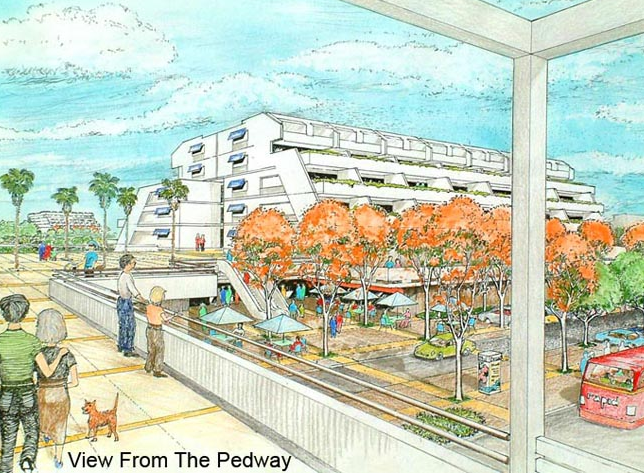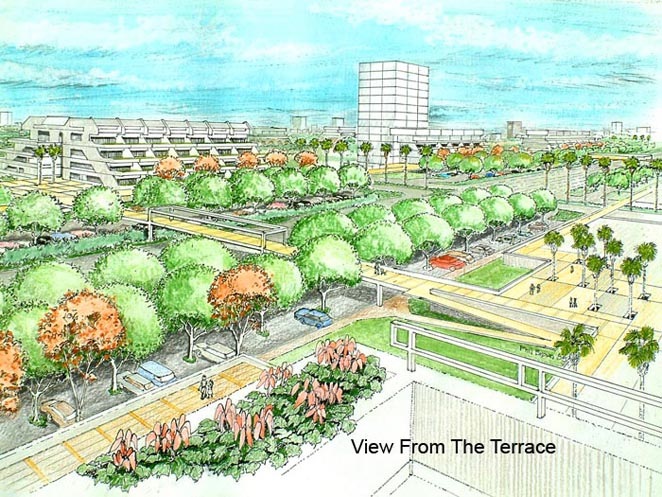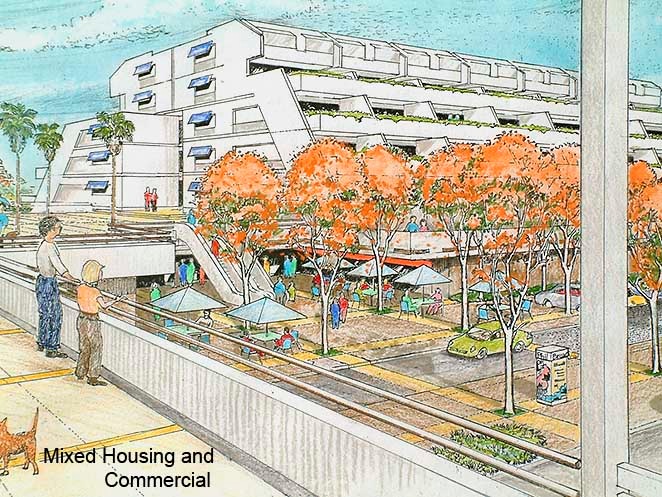FLOW BOULEVARD
A Review in 2007
Abstract
First a summary using bullets is made describing Flow Boulevard characteristics and planning conditions calling for plans to design a better LA future. Following this are brief Abstracts made in 2007 of the then “to date” studies. Then, further commentary is made covering the solving of congestion and transportation needs by improving community environment in an evolutionary process to build a magnificent city. This is beyond just trying to improve commuter travel.
INTRODUCTION
EVERYTHING EVOLVES
BULLETS OF THE FLOW BOULEVARD CONCEPT
- Flow Boulevards (FBs) are essentially the logical evolution of the existing developed corridors to a better future that solves congestion, provides housing and develops better land use and environment.
- The huge expected population and housing growth can make Los Angeles into a magnificent city. Communities and transportation improvement must be planned for together. Be sure to read the LA City Network section (a 135 mile rapid bus transit network).
- Basically each corridor, or corridor segment, goes through three stages of growth starting from the existing street right-of-way (ROW). So the corridor evolves as needed and where needed. Each stage may take anywhere from 5 to 25 years to evolve.
- Using density instead of sprawl for growth in Los Angeles, you gain a “green” or efficient city. Adding housing near employment and shopping, walking or reducing travel time distance and congestion, making “civic sized” automobiles as well as mass transit practical, an efficient city form may reduce fuel consumption by 30 to 50 percent
- The FB corridor growth is primarily a private enterprise activity (building for housing and employment) with the public support of FB road construction. Public and private development builds the pedestrian circulation (pedway) and open space system. This means many new jobs for many years becoming the better city establishing the new employment and housing areas.
- Because FBs are centers of activity, different corridors develop different character and roles within the city.
- You already have the basic street ROWs so the improved access is low cost. Improved access occurs in developed corridors, so it occurs where it is needed.
- Flow Boulevards extend the life of the freeway system (eliminates congestion) by taking local traffic off of freeways and thereby letting regional trips flow freely.
- Flow Boulevards establish the pedestrian circulation and open space system as an integral and desirable urban amenity for the grand world class city.
- It should probably be said that when corridors are designated to be Flow Boulevard corridors, the existing owners of property in the corridor would experience value appreciation. It may not be large at first, but it should appreciate steadily as the improved future of the corridor improves.
ABSTRACT SUMMARY OF SECTIONS
LA FB NETWORK A new building era is being entered into. Los Angeles will grow without sprawl. The greater density can result in a magnificent city if planned for appropriately. The Los Angeles Citywide FB Network Plan lays out the corridors to receive transportation improvement and the majority of new housing and development. This is a realistic plan because it uses affordable bus transit on exclusive lanes and evolves existing boulevard corridors as it should. The LA FB Network section sets out basic urban design considerations consistent with the Southern California Association of Governments 2030 population projection resulting in a distribution of new dwellings on the various elements of the FB citywide network. Development and growth is on a scale that Los Angeles has not seen in years. The intent is that all of Los Angeles benefits economically, experientially and socially in building a magnificent city. The 500,000 new dwellings that are expected are allocated to the various elements of the network. With this disclosure one can see that each element is a “custom design affair” taking on individuality and special character giving unique character to the new neighborhoods.
WESTERN AVENUE FB This FB corridor would be a medium sized development as compared to the grand scale of the Venice-Washington FB. The same elements occur but it is anticipated that it will be more like a lineal medium density neighborhood with some adjacent development. Three lanes north and south and raised pedestrian circulation are the basic infrastructure land use development builds upon. Explained in this section is the fact that the FB grows lineally. The first segment may just be 2 ½ miles long (Melrose to Olympic). It would extend as interest and demand proceeded.
FLOW BOULEVARD 2006 Beginning with the traffic congestion and planning dilemma Los Angeles has got itself into, the FB explanation develops into an urban design thesis to get L.A. out of the traffic snarls into the better city and environment. The corridor, roads and environment should be evolved as well as the busses and automobiles. The socio-economic reality would evolve as well, to a more sophisticated and capable level, employing organizational and building methodologies such as block corporations and three dimensionally organized community elements. Sensible planning can get us started to build, and to live, in that dream city.
HOW THE FLOW BOULEVARD WORKS Without becoming too technical, this section explains the relationship of elements that brings the improved highway capacity and the key element of raised pedestrian circulation. The corridor eventually becomes like a lineal super block organization where vehicles circulate in a network of their own, and pedestrians circulate in a safe, aesthetic, humanly scaled environment, of their own. Stage One begins where the pair of one way streets, separated by a block or more, are designated. Cross streets and pedestrians are still at ground level and utilize signals to stop traffic in order to proceed. The traffic improvement comes with not having left hand turns to stop opposing traffic (18% +or- increase in capacity), and with platooning (grouping traffic in packs) of vehicular traffic with synchronized lights so traffic does not have to stop at signals (a 40 to 50% increase). Stage Two traffic flow improvement occurs with the process of building raised pedestrian circulation and open space in the FB corridor with pedestrian bridges over the FB streets along with cutting out unnecessary cross street traffic (Cul-de-sac or vacate). Essentially you are reducing the number of signals that would stop vehicular traffic allowing larger streams of vehicles to flow with less restriction. On a lane per lane basis you have more than doubled the capacity over the existing operation. In many corridors you would be able to add lanes to the corridor as well. Also at this stage, grade separated cross streets at key locations are beginning to be employed. Stage Three occurs when the raised pedestrian circulation is complete as well as grade separated cross streets (in 50 years?). In the future you can bet on various technological capacity improvements as well (vehicle and computer, and combinations). Once Stage Three is achieved two hundred and fifty percent increases and more, in capacity over the existing, would be expected. In Stage Three, the FB has become a continuously flowing boulevard in the 35 to 40 mph speed limit.
COMMENTS ON RAIL TRANSIT This section strives to get the right focus on public transit by showing that heavy rail subway is a destructive force in reality and that the most realistic and constructive force to building an overall city network of public rapid transit is with the use of the flexibility of busses running on FBs and regular boulevards. There are comments on policy and the difficult position the MTA is in trying to balance all the contradictory demands of its constituent cities.
ARCHITECTURAL CONSIDERATIONS Beginning with practical considerations such as noise generating traffic next to land uses, this section then goes on to touch upon “air rights”, mega-structures, multiuse buildings and making the future city. The structure and facility to build the new city upon is the network of Flow Boulevards.
ABOUT PHIL BROWN A professed commitment to better urban environment is stated. A brief professional history, and a short history of the Flow Boulevard concept, starting with the original proposal in 1973, is made.


The Flow Boulevard concept develops corridors that can make Los Angeles into a grand design, with pedestrian oriented open spaces and urban amenities, medium rise housing with terrific views and highly accessible commercial and institutional land use. Unlike freeways which divide communities, Flow Boulevards become the center of communities. Unlike expensive rail transit in tunnels (a totally unaffordable citywide system) and light rail on out of the way abandoned railroad lines, the evolution of existing boulevards promotes and extends existing settlement patterns and in the sunlight of the day. In that the transportation improvement takes place within existing street right of ways (ROW), the low cost allows money to be directed towards development of pedestrian circulation and towards helping people develop their properties and communities.
What would take place is the building of an efficient, yet richly varied, new city form. Less travel time would be evident, less money to make a complete public rapid transit system would be expended, the per capita use of fuel would be less, but the variety and extent of human choices and experience would be more. And many of these would be within walking distance!
Los Angeles has been sprawling for the last 50 years, it is time to capture the richly varied yet efficient new city form through the next 50 years. The metropolitan areas of cities in large industrialized countries world wide are generally twice the density of Los Angeles, i.e. London, Paris, Moscow, New York, Tokyo and Mexico City. Many areas within these cities with walking distances and adequate transit have densities eight or more times the average density of Los Angeles. I would think that 25% or even 50% more density in Los Angeles, if designed correctly, would be to our benefit. It would follow the often quoted Mies Van Der Rohe dictum “less is more”. In this case, “more” begins with the ”less” travel distance provided by building greater housing density within our corridors on the higher transportation capacity Flow Boulevards.
The significance of building greater density in corridors, is that it will be in the right place. The high vehicular capacity and rapid transit facility serves the greater density of housing, commercial and employment directly. The corridors still provide the traditional distributed service functions to neighborhoods, but because of improved transportation, you can get you to larger centers quickly along the FB. Beyond that, recognize that the freeway system benefits by having missing segments “infilled” by FBs so that local traffic can be taken off freeways (see the two charts below showing a hypothetical relationship of the Venice-Washington FB and the Western Avenue FB). On the local street scale, what the FB allows is ”through traffic” to be kept out of residential neighborhoods (see the section, How the FB Works). Flow Boulevards would make the entire system work better as well as building great environment.


OK, the Flow Boulevard helps circulation in Los Angeles, but what does it do for the people that live there now? Answer, it gives them a very grand future; 1/ The city must help them develop, 2/ They have first right of choosing, 3/ Their needs are the communities need to be provided for, and 4/ The longer they participate the better off they are.
The priority for this transportation concept is;
- Top priority is to provide for the success and to realize an enhanced future for the people that live in the corridor now. Others may buy into it as time goes on, -it’s a free market-.

- The second priority is that the pedestrian open spaces and circulation along with new housing, commercial and institutional, will be realized. Los Angeles will be a great city to live in.
- Last but not least is the fulfillment of the transportation improvement; of providing rapid bus transit, of moving cars, goods and services efficiently.

The priorities are just opposite the usual deal. Usually the people in an improvement corridor are somehow impacted or removed. The communities are divided, disoriented, demolished or ignored, certainly with freeways Maybe a few get sweetheart deals if by luck or by connections, in that the only objective is to improve transportation and mainly for someone else.

The Flow Boulevard concept reverses that condition. To make the Flow Boulevard work best, what is built is the pedestrian circulation and open space because, - you already have the roadway -! Because you have the roadway it is low cost improvement. Tax dollars for transportation improvement can go to community needs in effect. The raised pedestrian circulation and raised arterial crossings (on a one mile interval), make the Flow Boulevard work better and better as these facilities are completing (see the menu section, How the Flow Boulevard Works ). Because the city benefits from improved adjacent properties (tax base), it must do the heavy lifting regarding development procedures for the individuals and block corporations (see text Flow Boulevards 2006) made up of people in the community. By heavy lifting I mean, the city does the transportation studies, the impact statements, and most of the permitting for construction, not the citizen developers. The city, and or other institutions arrange; start up money, land loans, money for plans, construction and permanent financing. And how does this happen? It happens because it helps practically everyone and is incredibly lucrative both economically and socially.

The city can overcome congestion and that works for everyone. The corridors can be renewed to provide better land use and environment. That helps the existing people and future arrivals in the corridor. A strong urban middle class in a grand and beautiful city will be the result.

For reference to the planning context the Flow Boulevard concept sets within, go to www.scag.ca.gov (click on Destination 2030 and also COMPASS). SCAG is the regional planning organization for Southern California. They are projecting, in their plans, that 6.3 million more people will move into the Southern Cal area in the 2004 to 2030 time span. They also expect congestion to double if present trends continue, worse pollution and only 40% of the population will be of wage earning age by 2030. They have two basic growth pattern scenarios, 1/ “infill” and 2/ “fifth ring”, or new satellite cities further out. My Flow Boulevard concept would fall into the “infill” pattern of growth. The SCAG plans never get specific enough to really say what their plans would be, what systems would be employed or what the growth area looks like. So I would say, that is what I am doing and I hope that at some point they can accept the Flow Boulevard concept. Another question they fail to describe is; what happens after 2030? I think the solid contribution the Flow Boulevard concept makes is that it establishes a framework for growth that would extend out 100 years. That is because Flow Boulevards become Continuous Flow Boulevards. The capacity for moving people, and therefore the framework growth can be built upon, grows and grows. But for now, it is best to focus on the beginnings of FBs and the short term.
There are many corridors that can receive the benefit of the Flow Boulevard approach to improvement. In this present proposal I am showing three corridors. We have been told that rail transit is what is needed in Los Angeles. Now you can know a better way to both improve transportation and land use. Look and read through the entire website to become more convinced and knowledgeable of what is happening and what can happen in Los Angeles.
You will find that much of the text is written in first person singular. Consider this a letter from me, Phil Brown, to you, Los Angeles. I have quickly put this proposal together thinking there is some urgency, and consider it only as a preliminary. There are no final plans here.